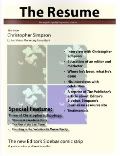When Boojums attack!
In the midst of the word he was trying to say
In the midst of his laughter and glee
He had softly and silently vanished away
For the snark was a boojum, you see.
-- Lewis Carroll, "The Hunting of the Snark"
Recently I suggested that a client change the name of his product (a platform for virtual tradeshows) and completely revamp his website. Not only was the name meaningless to the average prospect, but his website seemed to be talking about something entirely different.
Names are important. They’re the first thing most people ever know about a product or service and should convey something about its nature. All too often, however, names appear to be chosen as an afterthought.
Truly bad names can be avoided with a bit of thought. Whoever came up with “Poolife” for a pool cleaning service obviously wasn’t completely clear-headed at the time. Other times the name itself may be fine, but as a URL new and unwanted meanings emerge. As an example, “John,” of the Bad Product Names blog, tells the following (possibly apocryphal) story.
An employee at a software company was fired for visiting a particular website. Which site was it? Experts Exchange. But why? It seems like a legitimate site that one would go to in order to find help on various topics.
Most often, however, the problem isn’t a bad name (such as “Crooks Accounting”), but a name that fails to give any real information, and the technology industry is the worst culprit. Matthew Stibbe, of the Bad Language blog, calls technology product names “a rich vein of terrible writing”:
For example, what are the following products from one well-known manufacturer: dv8000z, PSC 2350, vp6300? One is a printer, one is a laptop computer and one is a projector. How can you tell? How can you differentiate one product in a given range from another? The answer is, quite simply, that you can’t. (Matthew Stibbe: Bad Language.)This is essentially what I faced with the creator of the virtual trade show platform. He was first and foremost a programmer and engineer with a stunning amount of expertise (bluntly put, he’s something of a bloody genius), but when it came to describing his service he could only speak to fellow programmers. With the change of a name, however, and a bit of guidance on articulating the purpose of his service, he was able to create a new website which showcased his product in an intelligent and engaging manner.
But names aren’t the only culprits, and sometimes even the worst of them can be overcome with good products. “Bowel Buddy” is a popular brand of cookie in certain regions, and Fluke Trucking actually capitalized on its rather unfortunate name with a clever tagline: “If it’s on time, it’s a Fluke.”
What’s worse is when bad instructions and “help” features drive away existing clients.
The people who chose “Second Life” did themselves proud. Not only is it understandable, it describes the service in two concise words. It’s just too bad the name was the extent of their communicative talents.
One of the most common complaints against Second Life is its difficulty — but why? Learning to move your avatar and interact with things really isn’t hard, and while camera movements require a bit more time, surely most people have mastered it in under an hour.
So what makes Second Life “difficult”?
I would have to lay the blame on its almost aggressively incomprehensible jargon. I used to be a programmer (many, many years ago) and the one thing I would never think of doing is playing with another programmer’s debug settings. Yet in SL the Debug Settings are precisely where we have to go if we want to enhance our in-world experience.
And then, when new residents finally discover the value of Debug Settings, they’re faced with the almost offensively cryptic nature of the options. What, for instance, does AutoMimeDiscovery do — check the surrounding area for unspeaking, white-faced avatars trapped in invisible boxes? And what about CheesyBeacon, DisplayAvatarAgentTarget and FlycamAxisDeadZone1? The descriptions accompanying them are little more than a reiteration of the names. CheesyBeacon, for instance, enables “cheesy beacon effects,” while the FlycamAxisDeadZone1 is described simply as “Flycam axis 1 dead zone.”
Yep. That helps.
Residents are often encouraged to use the available support features, but many find the explanations to be a labyrinth of jargon. When a new resident (read “new customer”) is faced with enough unfathomable jargon, the natural reaction is to simply go away — a problem with which Second Life is quite familiar (15,000,000 registered users versus a few hundred thousand active residents).
Part of marketing your product or service occurs up front with things like names and advertising campaigns. The rest takes place behind the scenes. If you’ve succeeded in acquiring new customers, don’t chase them away with incomprehensible instructions. Bad names, bad URLs, and bad customer features can all add up to some pretty nasty Boojums which, if not dealt with quickly, can lead to your customer base “softly and silently” vanishing away.






